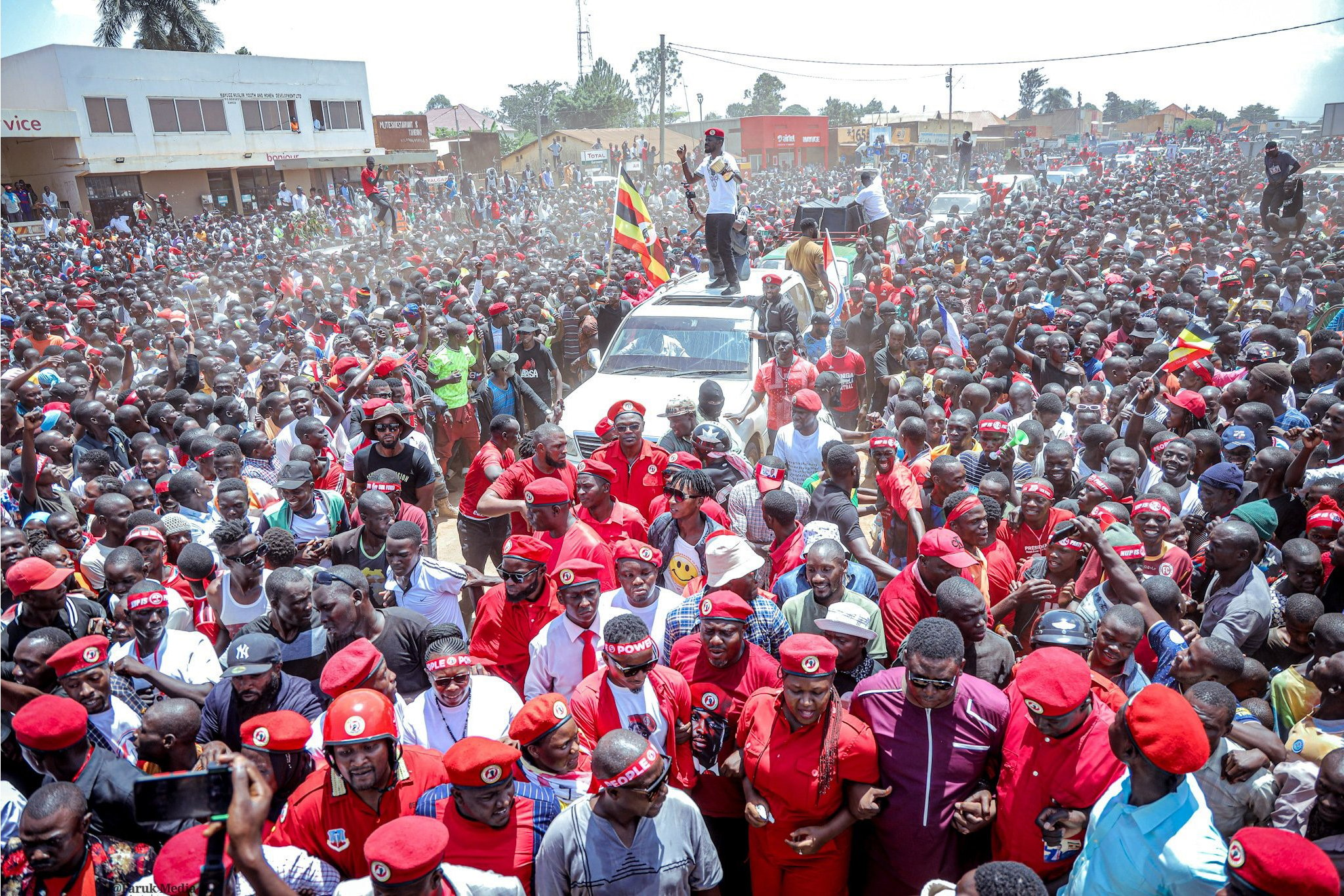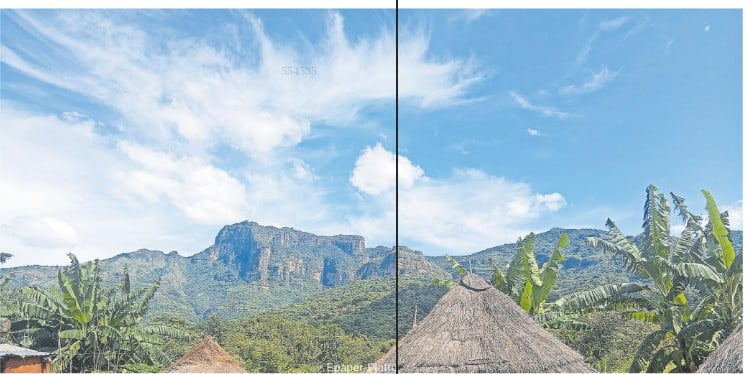Prime
Why crowds are taking centre stage as 2026 takes shape

National Unity Platform (NUP) party leader Robert Kyagulanyi, alias Bobi Wine, addresses supporters in Mayuge District on September 4. PHOTOS/ FILE
What you need to know:
- As the country gets ready for the 2026 General Election, different political actors, including National Unity Platform’s Robert Kyagulanyi, alias Bobi Wine, have hit the campaign trail.
- With Covid-19 measures no longer applicable, Derrick Kiyonga writes that campaigns are likely to be dominated by politics of crowds than the issues.
When asked what the intention of his two weeks countywide jamboree was about, National Unity Platform (NUP) leader Robert Kyagulanyi insisted that he wasn’t campaigning for the 2026 General Election, but rather he is on a sensitisation drive.
“I am speaking to the people, not in search of votes or for campaigning purposes, but to remind them that they hold the power to remove [President] Museveni. We should find ways for him to step down or engage in negotiations for his exit,” Kyagulanyi, popularly known as Bobi Wine, said.
Yet to many political experts, Kyagulanyi is using the merry-go-round to reassert himself as a crowd mover, not only in Buganda sub-region, which he won by a landslide in the 2021 presidential elections, but also the rest of the country.
“He has shown that indeed people like him across the country. He wanted to show that 2021 wasn’t just a one off and he has been able to show that people love him,” Yusuf Serunkuma, a socio-political analyst based at Makerere University, says.
Indeed, throughout his tour that has seen Kyagulanyi move to President Museveni’s strongholds of western Uganda, to Bugisu via Busoga and to Lango in the north, his proxies have bragged that the crowds that they have drawn across the country are a clear sign that NUP is popular.
“Apparently, all these people were ferried from Kampala to Mayuge,” NUP spokesperson Joel Ssenyonyi commented as thousands welcomed Kyagulanyi in the eastern district that he won in the 2021 elections. But NUP wasn’t able to get a single MP from that side.
When Kyagulanyi was received by an equally raucous crowd in the border town of Busia, still the emphasis was put on the crowd.
“Thank you, people of Busia for coming out in multitudes and making a statement that enough is enough,” Ssenyonyi said.

First Son, Gen Muhoozi Kainerugaba, addresses his supporters in Teso sub-region last month. PHOTO/ COURTESY of @mkainerugaba X handle
Muhoozi crowds
Kyagulanyi’s group isn’t a lone ranger in trying to show political muscle throw sheer number of crowds as Gen Muhoozi Kainerugaba, Museveni’s son, has for months been moving across the country with many of his supporters bragging about crowds they have attracted.
When Muhoozi visited Teso sub-region in August, Mr Peter Ogwang, the State minister for Sports who fashioned himself as the General’s coordinator in the region, boasted about the crowds.
“Thank you, brother, Gen Muhoozi Kainerugaba for returning to Teso to listen to the voices of our people. The massive crowds showed how much people appreciate your selfless efforts and bravery to rescue them from the bloody hands of the LRA [Lord’s Resistance Army] rebels,” Ogwang said.
“To those who contributed to the success of this Baraza in one way or the other, may the good Lord bless you unconditionally. Hope to see you soon in due time, General,” he added.
In Uganda, political rallies can be great theatre, with candidates roaring catchy slogans and bragging about the size of crowds which they try to project through the use of drone-taken pictures.
“When you have big crowds, it’s very easy for people to influence the voters more as serious people than when you have smaller crowds,” Mwambutsya Ndebesa, a senior lecturer at Makerere University’s College of Humanities and Social Sciences, says.
“Crowds are a major indicator of the success of any event. A big crowd is the best way to outshine and scare your opponents,” he adds.
Indeed, one of the things that are said to have killed former prime minister Amama Mbabazi’s presidential campaigns in their infancy was the relatively small crowd he attracted on nomination day.
“It showed that he had no support from day one. He didn’t get the momentum you need as a politician and that momentum comes with attracting big rallies,” Prof Sabiti Makara, a former senior lecturer at Makerere University’s Department of Public Administration and Political Science, says.
No wonder, Museveni, who has been in power since 1986 and is believed to want to hand over power to Muhoozi, has taken the issue of crowds seriously, with his campaign team normally giving out free transport, food, and drinks to those who attend.
“He doesn’t want to be embarrassed by poor crowd turnout. That’s why a lot of money is spent on ensuring people come to Museveni’s events, including those which are not political,” says Ibrahim Ssemujju Nganda, the Kira Municipality legislator.
“There was sense that his [Museveni] crowds were dwindling in Buganda and you saw how he was beaten in Buganda in 2021,” Ssemujju adds.
According to Peterside Adol Dakuku a Nigerian politician, across the globe, crowds serve the same purpose in politics.
“A show of strength, influence the people’s minds, create the perception of popular support and acceptance, and generate media buzz and optics. It has nothing to do with believing in the candidate, his cause, or even campaign message, and it is only for the non-discerning to judge the possible outcome of an election with a crowd at campaign rallies,” Dakuku says.
In the US, former president Donald Trump has accused the media of undercutting him by not showing his big crowds.
“You’re so negative,” he accused the media. “These are the biggest rallies we’ve ever had. You just come in here with that negative attitude.”

A man casts his ballot in Kampala during the 2016 elections.Photo/File
2016 presidential campaign
In Uganda, the 2016 presidential campaigns went down to politics of the crowd with Museveni, who was declared winner, drawing first blood.
New Vision, the State-owned newspaper, had on its front page an almost full-page photo of a brim-full crowd at the President’s nomination rally at Kololo Independence Grounds in Kampala. The National Resistance Movement (NRM) party organisers ensured every person who attended the rally was dressed in some form of yellow attire – the colour of the NRM.
Forum for Democratic Change’s (FDC) Kizza Besigye, who was declared second by the Electoral Commission, was nominated a day after Museveni.
He had put up a show when he moved with a mammoth crowd at walkers’ pace from Najjanankumbi [FDC headquarters] to Namboole stadium and then to Nakivubo stadium, in downtown Kampala.
In total, it took approximately 10 hours for Besigye to arrive at Nakivubo Stadium where the nomination rally was hosted.
“Ours is not a campaign of using helicopters to fly for campaigns. If it means walking. I will do that...I don’t have billions for campaigns like my competitors. It’s you who will contribute to our struggle,” Besigye said after being nominated.
During the 2021 campaigns, politicians couldn’t legally show off crowds following the ban on big gatherings by the government as a measure of curbing the novel Covid-19 disease.
“In the run-up to the 2021 election, the security forces arrested journalists and Opposition party leaders and dispersed or blocked Opposition campaign rallies with tear gas and live bullets for allegedly flouting Covid-19 guidelines. Despite attracting similarly large crowds, security forces allowed rallies and processions for the ruling NRM party to continue uninterrupted,” Badru Bukenya and Paul Mukwaya wrote in their paper titled Politics and Covid-19 in Kampala.
“Still in December 2020, the Electoral Commission, working on the advice of the Health ministry, stopped campaigns in the populous central Ugandan districts with claims that Covid-19 infections there were fast rising. Critics interpreted this as a deliberate move to block campaign rallies in Opposition strongholds while giving the incumbent an advantage,” they added.
With Covid-19 measures now a distant memory, Kyagulanyi’s NUP, who were surprisingly allowed to crisscross the country, want to send a political message by organising big gatherings.
“We began in Mbarara, and we experienced a significant turnout, even amid the uncertainty of whether security operatives would be deployed or tear gas would be used. We are grateful for that support,” Kyagulanyi said.
“We aim to transform the support we have in terms of numbers and crowds into tangible action. We want people, like those who turned up in our mobilisation drives, to rise up and actively demand change because it is acceptable.”
Although numbers are important in politics, experts insist that Kyagulanyi has been raising pertinent issues rather than the crowd.
“The media has fallen prey to this crowd thing. The only person who had nothing to offer apart from the crowds was Muhoozi. Kyagulanyi has been discussing critical issues in the country like the sugarcane crisis in Busoga,” Serunkuma says.
Although NRM/Muhoozi has dismissed Kyagulanyi’s crowds, insisting that he is popular in Busoga and Buganda, they have said they will soon be responding with their own crowds.
“We shall soon put out a programme and show that we have the numbers. We went to Mayuge without Gen Muhoozi and we got big numbers but what will happen when we go with him?” David Kabanda, the Kasambya County Member of Parliament (MP), says.





